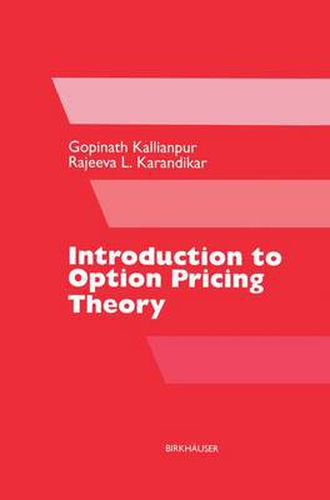Readings Newsletter
Become a Readings Member to make your shopping experience even easier.
Sign in or sign up for free!
You’re not far away from qualifying for FREE standard shipping within Australia
You’ve qualified for FREE standard shipping within Australia
The cart is loading…






This title is printed to order. This book may have been self-published. If so, we cannot guarantee the quality of the content. In the main most books will have gone through the editing process however some may not. We therefore suggest that you be aware of this before ordering this book. If in doubt check either the author or publisher’s details as we are unable to accept any returns unless they are faulty. Please contact us if you have any questions.
Since the appearance of seminal works by R. Merton, and F. Black
and M. Scholes, stochastic processes have assumed an increasingly
important role in the development of the mathematical theory of
finance. This work examines, in some detail, that part of stochastic
finance pertaining to option pricing theory. Thus the exposition is
confined to areas of stochastic finance that are relevant to the
theory, omitting such topics as futures and term-structure.
This self-contained work begins with five introductory chapters
on stochastic analysis, making it accessible to readers with little or
no prior knowledge of stochastic processes or stochastic analysis.
These chapters cover the essentials of Ito’s theory of stochastic
integration, integration with respect to semimartingales, Girsanov’s
Theorem, and a brief introduction to stochastic differential
equations.
Subsequent chapters treat more specialized topics, including
option pricing in discrete time, continuous time trading, arbitrage,
complete markets, European options (Black and Scholes Theory),
American options, Russian options, discrete approximations, and asset
pricing with stochastic volatility. In several chapters, new results
are presented. A unique feature of the book is its emphasis on
arbitrage, in particular, the relationship between arbitrage and
equivalent martingale measures (EMM), and the derivation of necessary
and sufficient conditions for no arbitrage (NA).
{\it Introduction to Option Pricing Theory} is intended for
students and researchers in statistics, applied mathematics, business,
or economics, who have a background in measure theory and have
completed probability theory at the intermediate level. The work
lends itself to self-study, as well as to a one-semester course at the
graduate level.
$9.00 standard shipping within Australia
FREE standard shipping within Australia for orders over $100.00
Express & International shipping calculated at checkout
This title is printed to order. This book may have been self-published. If so, we cannot guarantee the quality of the content. In the main most books will have gone through the editing process however some may not. We therefore suggest that you be aware of this before ordering this book. If in doubt check either the author or publisher’s details as we are unable to accept any returns unless they are faulty. Please contact us if you have any questions.
Since the appearance of seminal works by R. Merton, and F. Black
and M. Scholes, stochastic processes have assumed an increasingly
important role in the development of the mathematical theory of
finance. This work examines, in some detail, that part of stochastic
finance pertaining to option pricing theory. Thus the exposition is
confined to areas of stochastic finance that are relevant to the
theory, omitting such topics as futures and term-structure.
This self-contained work begins with five introductory chapters
on stochastic analysis, making it accessible to readers with little or
no prior knowledge of stochastic processes or stochastic analysis.
These chapters cover the essentials of Ito’s theory of stochastic
integration, integration with respect to semimartingales, Girsanov’s
Theorem, and a brief introduction to stochastic differential
equations.
Subsequent chapters treat more specialized topics, including
option pricing in discrete time, continuous time trading, arbitrage,
complete markets, European options (Black and Scholes Theory),
American options, Russian options, discrete approximations, and asset
pricing with stochastic volatility. In several chapters, new results
are presented. A unique feature of the book is its emphasis on
arbitrage, in particular, the relationship between arbitrage and
equivalent martingale measures (EMM), and the derivation of necessary
and sufficient conditions for no arbitrage (NA).
{\it Introduction to Option Pricing Theory} is intended for
students and researchers in statistics, applied mathematics, business,
or economics, who have a background in measure theory and have
completed probability theory at the intermediate level. The work
lends itself to self-study, as well as to a one-semester course at the
graduate level.